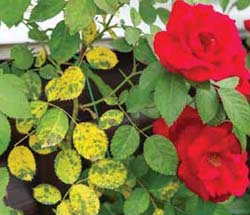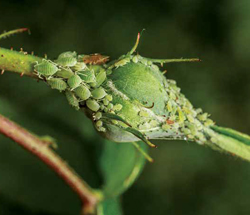 Leaf yellowing is symptomatic of a variety of problems, most of which can be pigeon-holed into four main categories that is, enviromechanical problems, nutrient deficiencies, pest damage, and disease damage. Its one of the symptoms that can be noted whenever a plant lacks or have had too much of something as it grows. When for example there is excessive fertilizer, irrigation, chemicals and nutrients the leaf tissues turn yellow whereby growth may become stunted. Other symptoms that go together with yellowing include reduced growth, scorched margins, fall of leaves and failure of blooms to open completely.
Leaf yellowing is symptomatic of a variety of problems, most of which can be pigeon-holed into four main categories that is, enviromechanical problems, nutrient deficiencies, pest damage, and disease damage. Its one of the symptoms that can be noted whenever a plant lacks or have had too much of something as it grows. When for example there is excessive fertilizer, irrigation, chemicals and nutrients the leaf tissues turn yellow whereby growth may become stunted. Other symptoms that go together with yellowing include reduced growth, scorched margins, fall of leaves and failure of blooms to open completely.
Enviro- Mechanical Problems
Heat Stress: This problem is brought about by Heat Stress where it is frequently noticed after wet and relatively cool weather, especially when the transition from spring to summer temperatures is sudden. Exposure of this new growth to direct sun can cause scorching of leaf.
This can be treated by applying anti-transpirants/anti-desiccants. Plant roses where they will receive protection from the hot sun and Mulch heavily around root zones to stabilize soil and near-surface air temperatures.
Water stress: There is Water stress that is, use of excessive irrigation, too much rain or improper drainage. Water displaces air in the soil. As a result, roots cannot support the rapid transpiration required during hot summers. Conversely, if too little water is applied, a drought condition exists.
This can be treated by improving drainage, reducing irrigation schedule in excessive water conditions and increasing irrigation schedule in drought conditions.
Growers who apply excessive amounts of water-soluble fertilizers to their roses frequently develop soil salt stress, especially in locations where soils tend to be heavy and/or where irrigation or rainfall fails to leach these salts beyond the root zone. Fertilizers containing high amounts of nitrate of soda, muriaate of potash, potassium nitrate and ammonium nitrate can cause the highest accumulated salts which build in the soil and competes with rose roots for moisture. The result is yellowed leaves and eventually plant death. Rain water and some water supplies can also contain dissolved salt ions in some locations. The chief culprit for causing salt stress is the chlorides.
This can be treated by Irrigating deeply (where drainage is good) to leach accumulated salts from the root zone but if drainage is unsatisfactory, consider adding gypsum before leaching. For containered roses, flush potting soils frequently and Change out the soil every three to four years.
Chief among reasons for yellowing leaves is “suffocation” caused by spraying – Phytotoxicity. When chemicals and/or their surfactants clog leaf pores (the “stomata”), plant tissues cannot transpire moisture and essential gasses, they cease producing chlorophyll, cell walls deteriorate, and the leaves yellow and eventually fall from the plant. Further, some roses are, by their nature, less tolerant of spraying than others. Rugosas and their near “cousins” – roses with textured leaf surfaces – seem to be the most affected.
 Still another form of phytotoxicity is caused by drift from nearby herbicide applications. This can be treated by avoiding spraying chemicals with high viscosity ingredients or If spraying is necessary, do so very early in the morning.
Still another form of phytotoxicity is caused by drift from nearby herbicide applications. This can be treated by avoiding spraying chemicals with high viscosity ingredients or If spraying is necessary, do so very early in the morning.
Often, in our zeal to nurture our roses, we may cultivate a bit too close to roots. This is a Mechanical problem. Damaging roots and destroying their associated micorrhizal fungi is essentially inducing a water and/or nutrient stress situation to the rose, thereby causing yellow leaves. One should use caution cultivating in and around root zones and if roots are exposed, trim away broken sections and replant immediately.
Nutrient Deficiencies
Nutrients come in two forms – mobile (“translocatable”) nutrients and immobile nutrients. The mobile nutrients are nitrogen, phosphorus, potassium and magnesium that can move quickly from the soil to the plant. The immobile nutrients are iron, sulfur, calcium, manganese, copper, zinc, boron, molybdenum, and chlorine and their movement is determined by their electrical charge. If positive, the nutrients bind with the soil and become unavailable – an insoluble precipitate.
This can be termed as Soil pH out of balance.
Although roses can survive a wide range of pH, they prefer their soil slightly acidic (6.5) to near neutral (7.1). This can be treated by doing a quality soil test, performed at least biannually and this will help determine not only the soil’s pH but the available nutrients it contains.
We have Iron deficiency (“chlorosis”)
Iron is one of the chief elements necessary for the production of chlorophyll – the molecule that makes green plants green. It also aids sugar burning enzymes which activate nitrogen fixation. And it regulates the respiration of the plant’s cells. To treat the flower add bone meal or blood meal organic amendments, or iron sulfate or chelated iron liquid or granular inorganic amendments.
There is Magnesium deficiency and like iron, magnesium promotes chlorophyll formation and vital to the photosynthetic process necessary to produce dark green foliage. It also promotes healthy, disease-resistant plants. To treat this, add fish meal, basic slag, greens and/or dolomitic limestone, or Epsom salt (magnesium sulfate).
On roses with yellow blooms, a lack of nitrogen frequently appears as yellow leaves. Nitrogen availability occurs in most soils with a pH above 4.5. If nitrogen is deficient, add blood meal, cottonseed meal and/or manure for organic amendments, or nitrate of soda or ammonia sulfate for inorganic amendments. Others include sulfur and manganese deficiency.
Nutrient toxicity
Zinc toxicity: Although it is rare, too much zinc can cause symptoms similar to iron or magnesium chlorosis. That is, the leaf tissues first turn yellow, and then turns brown. The main leaf rib remains green, but the secondary veins lighten. New growth may become stunted and bloom buds may be distorted.
Phosphorus toxicity
Phosphorus toxicity is becoming an increasing problem in areas where it’s over use has accumulated in clay-based soils. This is particularly important to growers who frequently succumb to the media hype and apply water soluble, high phosphorus fertilizers in hopes of achieving bigger blooms.
Potassium toxicity
Potassium toxicity appears the same as phosphorus toxicity, and for the same reasons. The chief difference is that too much potassium also manifests in root loss and consequently the wilting of tender new growth.
Treatments for too much “love” – that is, too many nutrients – is to reduce the amount of fertilizer applied.

Pests
Without a doubt, spider mites are the leading garden pest for causing yellowed leaves. When this mite attacks your rose, it pierces the epidermis and apparently injects some of its saliva in the process. After feeding, two minute chlorotic spots appear as the leaf tissue collapses. During severe infestations, the entire plant may turn yellow and die. You can have excellent success controlling pest mites on your roses by using the beneficial predatory mite called Phytoseiulus persimilis. It enjoys warm, humid weather and reproduces twice as fast as the pest mites. Research has shown that mites can quickly mutate to pesticide-resistant strains. If using synthetic pesticides, rotate between two or three different chemical types.
There is Whiteflies that are a member of the Homoptera Order of critters and thus related to the aphids, scales and mealy bugs. Like their plant-sucking cousins, whiteflies pierce leaf tissues causing noticeable wilting, chlorosis, loss of leaves and/or stunted growth. In addition, like their cousins, they produce “honeydew” which attracts other pests and produces a medium for “sooty mold” fungus. Use Biological controls like Beauveria bassiana, Paecilomyces fumosoroseus, or Verticillium lecanii fungi (the latter for greenhouse use); parasitoids like Encarsia Formosa and Eretmocerus californicus; and a host of other predators like lacewings, lady beetles, and predatory mites. Research has shown that whiteflies can quickly mutate to pesticide-resistant strains. If using synthetic pesticides, rotate between two or three different chemical types.
Disease
Blackspot: Of all the reasons for yellowing leaves, this disease is one of the primary causes. Damage usually begins as a black or brown splotch. Shortly after, the leaf tissues surrounding this spot turn yellow. In this case, the fungus exudes a chemical called ethylene to kill the leaf tissue as it advances; the result of this is the destruction of chlorophyll in the cell living tissue and the creation of a golden “halo” or yellow surface area indicating the dead tissue.
About treatment the pathogen is susceptible to fungicides within the first 90 hours but may not be noticed. For this reason, preventive fungicide applications are best made during susceptible periods of the year if these are your preferred control means.
Downy mildew: This disease is most commonly confused with Blackspot. But unlike its “cousin,” the damage is first noticed at the top, new-growth areas of the plant instead of the lower leaves as with Blackspot. Infected leaves develop purplered, irregular splotches. Mature stages of the disease manifest as gray fuzz or “down” on the undersides of leaflets and possibly yellow leaf surfaces. Its treatment is same as for Blackspot.
Brown Root Rot (Cylindrocladium sp: Cylindrocladium is a fungal pathogen found rarely among amateur rosarians. This may occur during greenhouse propagation of rose cuttings. Brown Root Rot first begins near or just below the soil’s surface. Leaves turn yellow as the pathogen begins to kill the cutting. To treat use Fungicidal soil drench. Viral Diseases (Rose Mosaic): The most common of the viral diseases, Rose Mosaic symptoms are yellow, staggered patterns on the leaf. These patterns frequently look like yellow electrical streaks or veins. There is no treatment for rose mosaic.
